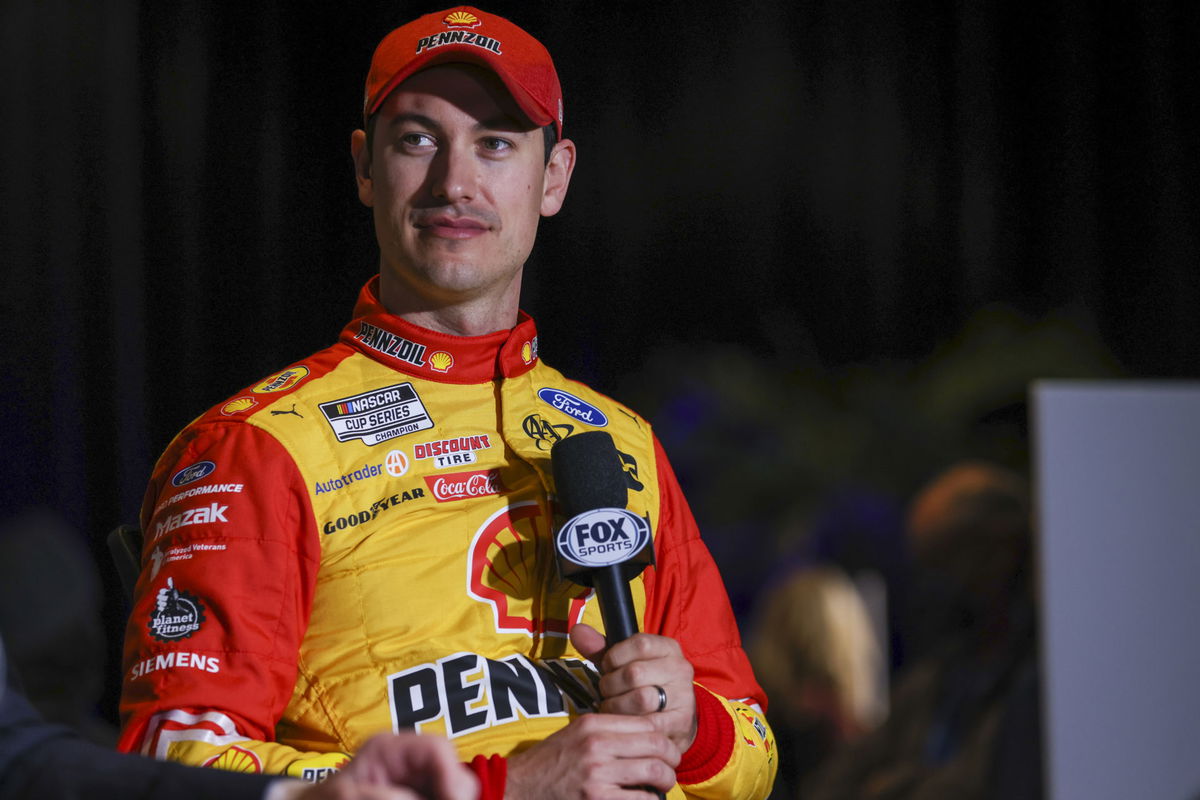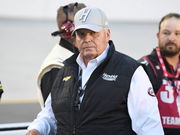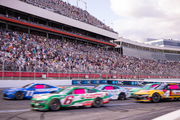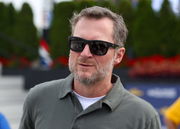
Getty
DAYTONA, FL – FEBRUARY 16: Joey Logano, driver of the #22 Pennzoil Team Penske Ford Mustang Shell, fields questions from the media during Daytona 500 Media Day on February 16, 2022 at Daytona International Speedway in Daytona Beach, Fl. (Photo by David Rosenblum/Icon Sportswire via Getty Images)

Getty
DAYTONA, FL – FEBRUARY 16: Joey Logano, driver of the #22 Pennzoil Team Penske Ford Mustang Shell, fields questions from the media during Daytona 500 Media Day on February 16, 2022 at Daytona International Speedway in Daytona Beach, Fl. (Photo by David Rosenblum/Icon Sportswire via Getty Images)
He showed up, stole the show, and took off! That’s the best way to sum up Joey Logano’s killer performance at the North Wilkesboro All-Star race. He was out front more than anyone else and zoomed past the checkered flag, a cool 0.636 seconds before Denny Hamlin, who had to settle for second place. Logano and his crew are now a million bucks richer, thanks to the hefty bonus for winning the All-Star Race.
Watch What’s Trending Now!
The victory marked Logano’s second All-Star win and Team Penske’s fifth, with previous wins, chalked up by Kurt Busch in 2010, Ryan Newman in 2002, and Ryan Blaney in 2022. But how did that happen with the new ‘option‘ tires, which were meant to fall off faster?
ADVERTISEMENT
Did Joey Logano’s massive win come from Goodyear dropping the ball?
Joey Logano, driving the #22 for Team Penske, pretty much owned the track by leading 199 out of 200 laps during the main event. He kicked off from the pole position after nailing the fastest qualifying time on Saturday and basically sailed through without much competition, setting a record for the most laps led in the race’s 40-year history. It was a sweet victory for Team Penske and Logano, snapping a winless streak that stretched back 44 races to their last triumph in Atlanta the previous year.
While Logano didn’t rack up any points, he did pocket a cool $1 million with his second All-Star race win since 2016. He shared in his post-race interview with a constant brink of smile, “The all-star wins are always so special and… It’s been a while since I’ve been a victory lane, to be honest with you, so we have been sitting there like just saying we got a win one of these things so it uh I know it’s no points paid but there’s a lot of money paid we’ll take that for sure and uh I built some momentum off of it it’s definitely a help.”
But it seemed like Joey Logano’s win might have had a little help from Goodyear and the freshly repaved track. Both were supposed to up the grip, but the tires were expected to wear down quicker than usual. Turns out, the new ‘option‘ tires were actually holding up better than the standard ones. Even Joey Logano himself said, “If we did not have to pit stop those on, we would have led every single lap. The only lap we didn’t leave is because we were in our pit stall and we put it behind the start finish line.”
ADVERTISEMENT
During the caution triggered by Stenhouse’s wreck, five drivers—Logano, Tyler Reddick, Brad Keselowski, Chris Buescher, and Ryan Blaney—kept their softer option tires on while the rest of the pack hit pit road to switch to the primary tires. Staying on the track with the option tires turned out to be the golden ticket for the #22 Ford. When crew chief Paul Wolfe saw how well the car was doing on the option tires, he decided they wouldn’t switch to the primes at the 100-lap halfway point.
View this post on Instagram
ADVERTISEMENT
Earlier Greg Stucker, Goodyear’s racing boss, had chimed in saying that they tweaked the wet weather compound for both sides of the car, expecting the Option tires to be about four to five-tenths quicker per lap than the Prime tires on the five-eighths-mile track. He pointed out that the extra zip and grip meant the Option tires would wear down quicker, really putting the spotlight on tire management.
While some folks like Denny Hamlin were nodding along, saying the new tire was on point, his own teammate noticed that the tires didn’t wear out as much as they thought they would. The wild part? The option tires that blistered after just 40 laps in practice somehow held up for 100 laps during the main event. They only dropped off by three-tenths over a 100-lap stint, which wasn’t nearly as much as everyone had expected. But why didn’t the tire strategy pan out for the race right off the bat?
Top Stories
Rick Hendrick Strikes Fear in NASCAR Fans With Chevy’s New “Illegal” Car

New Charter Deal Triggers ‘Financial Frenzy’ as NASCAR Teams Set for Massive Payday

Martin Truex Jr’s Former Crew Chief Ends 12-Year Fight In Huge Personal Announcement

Denny Hamlin Gloats as Jim France Forced to Eat His Words Against Rick Hendrick & Co.

Dale Jr. Reveals How Permanent Charters Could Turn NASCAR Into a Billionaire’s Club With a Brutal Reality Check

ADVERTISEMENT
Why didn’t the option tire strategy shake things up at the race?
For the second time in eight years, NASCAR and Goodyear rolled out an option tire for their big spring showdown, but it didn’t quite stir the pot enough to influence the race’s outcome. Goodyear had pegged the option tire to be nearly a half-second faster per lap, thinking the real drama would kick in when the speed advantage would wear off and fall below that of the primary tire—the so-called crossover point.
The hitch on Sunday night was that the edge given by the primary tire was super short-lived, and it never actually became the better choice. So, most of the front-runners decided to stick with the option compound for the latter half of the race, since holding their track position turned out to be more crucial than slapping on fresh tires.
Denny Hamlin’s crew chief pointed out that racing at night instead of under the scorching daytime sun played a part. He explained, “The soft reds were not wearing terribly but they were getting really hot. […] It’s not wearing enough and I know Goodyear is working on it and I can’t imagine what they’re thinking right now, right? This is literally their rain compound, the softest thing they’ve ever made for a Stock Car that I know of and it’s not enough.”
ADVERTISEMENT
It wasn’t just Hamlin’s team that got thrown off by how the option tires held up; Kyle Larson‘s crew was also caught off guard. He shared, “For the record, I think we would’ve missed it by a country mile. Because we were almost thinking, that to start the race, the (options) were going to go really fast and then degrade pretty good. Maybe after lap 35 or so is kind of what we were thinking — that they would hold on for a little while. We did not at all see it coming that the (options) were going to hold on for pretty much 90 laps.”
Looks like Goodyear has some tweaking to do if they want to amp up the excitement and bring some of that Bristol-style thrill to future races.
ADVERTISEMENT
ADVERTISEMENT
ADVERTISEMENT

